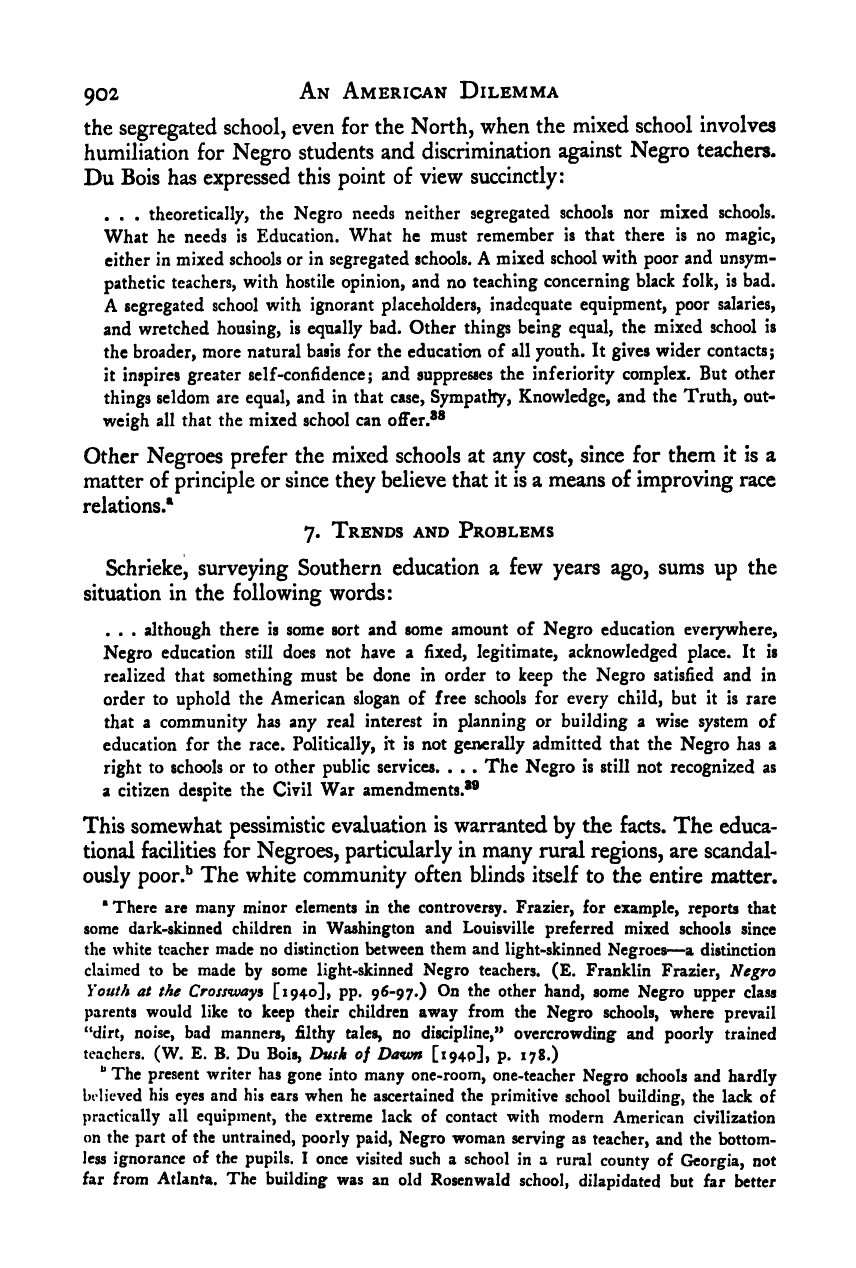Note: Gunnar Myrdal died in 1987, less than 70 years ago. Therefore, this work is protected by copyright, restricting your legal rights to reproduce it. However, you are welcome to view it on screen, as you do now. Read more about copyright.
Full resolution (TIFF) - On this page / på denna sida - IX. Leadership and Concerted Action - 41. The Negro School - 6. Negro Attitudes - 7. Trends and Problems

<< prev. page << föreg. sida << >> nästa sida >> next page >>
Below is the raw OCR text
from the above scanned image.
Do you see an error? Proofread the page now!
Här nedan syns maskintolkade texten från faksimilbilden ovan.
Ser du något fel? Korrekturläs sidan nu!
This page has never been proofread. / Denna sida har aldrig korrekturlästs.
902 An American Dilemma
the segregated school, even for the North, when the mixed school involves
humiliation for Negro students and discrimination against Negro teachers.
Du Bois has expressed this point of view succinctly:
. . . theoretically, the Negro needs neither segregated schools nor mixed schools.
What he needs is Education. What he must remember is that there is no magic,
either in mixed schools or in segregated schools. A mixed school with poor and unsym-
pathetic teachers, with hostile opinion, and no teaching concerning black folk, is bad.
A segregated school with ignorant placeholders, inadequate equipment, poor salaries,
and wretched housing, is equally bad. Other things being equal, the mixed school is
the broader, more natural basis for the education of all youth. It gives wider contacts;
it inspires greater self-confidence; and suppresses the inferiority complex. But other
things seldom are equal, and in that case, Sympathy, Knowledge, and the Truth, out-
weigh all that the mixed school can offer.*®
Other Negroes prefer the mixed schools at any cost, since for them it is a
matter of principle or since they believe that it is a means of improving race
relations.®
7. Trends and Problems
Schrieke, surveying Southern education a few years ago, sums up the
situation in the following words:
. . . although there is some sort and some amount of Negro education everywhere,
Negro education still does not have a fixed, legitimate, acknowledged place. It is
realized that something must be done in order to keep the Negro satisfied and in
order to uphold the American slogan of free schools for every child, but it is rare
that a community has any real interest in planning or building a wise system of
education for the race. Politically, it is not generally admitted that the Negro has a
right to schools or to other public services, . . . The Negro is still not recognized as
a citizen despite the Civil War amendments.*®
This somewhat pessimistic evaluation is warranted by the facts. The educa-
tional facilities for Negroes, particularly in many rural regions, are scandal-
ously poor.** The white community often blinds itself to the entire matter.
* There are many minor elements in the controversy. Frazier, for example, reports that
some dark-skinned children in Washington and Louisville preferred mixed schools since
the white teacher made no distinction between them and light-skinned Negroes—a distinction
claimed to be made by some light-skinned Negro teachers. (E. Franklin Frazier, Negro
Youth at the Crossways [1940], pp. 96-97.) On the other hand, some Negro upper class
parents would like to keep their children away from the Negro schools, where prevail
“dirt, noise, bad manners, filthy tales, no discipline,” overcrowding and poorly trained
teachers. (W. E. B. Du Bois, Dush of Dawn [1940], p. 178.)
^
The present writer has gone into many one-room, one-teacher Negro schools and hardly
believed his eyes and his ears when he ascertained the primitive school building, the lack of
practically all equipment, the extreme lack of contact with modern American civilization
on the part of the untrained, poorly paid, Negro woman serving as teacher, and the bottom-
less ignorance of the pupils. I once visited such a school in a rural county of Georgia, not
far from Atlanta. The building was an old Rosenwald school, dilapidated but far better
<< prev. page << föreg. sida << >> nästa sida >> next page >>